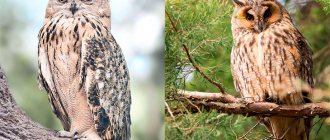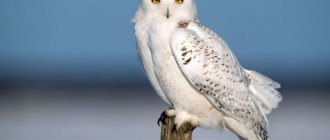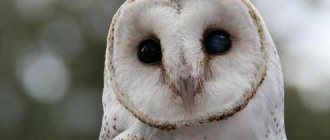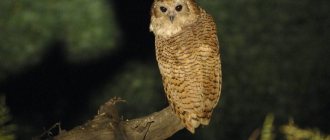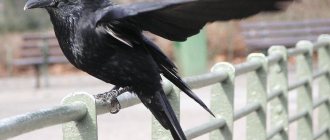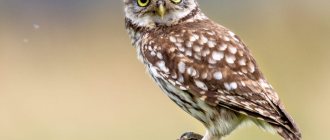Owls come in different types. Let's look at how the eagle owl differs from other representatives of the owl genus.
The owl family includes several groups of birds that differ from each other, and they also have common characteristics. Owls can turn their heads 270 degrees, their eyes have three eyelids: the first for blinking, the second for protection from insects, and the third for sleeping.
It is noteworthy that the birds live their entire lives in pairs with only one male. All birds: eagle owl, owl, owl belong to the owl family. But they have some differences, both in appearance, size, and in the method of hunting. Next, we will learn in detail how to distinguish where the owl is and where the owl or eagle owl is.
Is an owl an owl or not?
The eagle owl is one of the largest birds in the Owl family, which also includes owls and owls. Few people have information about the difference between an eagle owl and an owl; only a few are able to explain the differences to a child.
Great-footed owl
To begin with, you should understand that an eagle owl is not a male owl, but a representative of a separate genus, numbering about 20 species of birds, while there are many more varieties of owls. Its habits and appearance have a lot in common with the owl, but there are more differences between the birds than similarities. If you want to determine which bird is visible, you need to pay attention to:
- body composition;
- feather color;
- presence or absence of ears and facial disc.
Lifestyle is what distinguishes an eagle owl or an owl from an owl.
Plumage color
Most eagle owls are distinguished by a more variegated and spotted plumage color compared to owls. The latter are characterized by a uniform color of feathers.
Many eagle owls live in forest thickets, so more variegated colors give them the most camouflage appearance. Also, the difference between them and owls is the presence of clearly visible dark stripes on the head and upper back. In addition, eagle owls' paws are usually densely furred.
How does an owl differ from an eagle owl in appearance?
Information about the external characteristics of an owl and an eagle owl makes it easy to distinguish between these two birds.
Dimensions: who is larger
Eagle owls are larger. They are second in size only to the tawny owl. You can recognize it by looking closely at the body:
- body length is at least 65-75 cm;
- the distance between the open wings is 150-200 cm;
- females weigh 3 kg, males are somewhat smaller, weighing no more than 2.7 kg.
For comparison, the body size of the long-eared owl does not exceed 35 cm, and the wingspan is 85-90 cm.
Important! The only thing in the family that is larger than the eagle owl is the great gray owl. Her body reaches a length of 80 cm.
What they look like
The eagle owl has a barrel-shaped body. A distinctive feature of this type of bird is its “feather” ears; tawny owls and owls do not have these, so it is impossible to confuse them.
- Coloring
The feathers are variegated, with red and black colors predominating.
Tawny owls and owls are less bright, they are distinguished by monotony and purity of color. An example of this is white polar birds.
- Ears and facial disc
The facial disc is a white patch on the face that covers the area around the bird's eyes and beak. It is formed by 5 rows of hard, expanded feathers, folded into a corolla.
Available in all members of the family, with the exception of eagle owls. But nature has endowed the latter with ears, but owls do not have feathers sticking up or to the side, which are mistaken for ears.
Inhabitant of polar latitudes
- Plumage
The eagle owl's soft and loose feathers allow it to move silently, sneaking up on its prey unnoticed. Owls have flight feathers rounded at the ends.
The first three feathers, representing the outer web, have fringes or sawtooth serrations. The third and fourth feathers in the wing are longer than the others. Due to them, the bird moves without making unnecessary noise.
The tail is trimmed or rounded, shortened, the tail feathers that make up it are curved downwards.
Flight
The flight of an owl is practically silent, while during the flight of some species of eagle owl (for example, the fish eagle), sounds reminiscent of a whistle are heard.
The difference is in the wing plumage.
Owls have slight soft pubescence along the edges of their tail and flight feathers. The wing itself is rounded at the top, and the special bend of the fan suppresses the sound of feathers rubbing against each other. The terminal grooves along the edge of the outer webs are only partially interlocked. All this contributes to its silent flight.
Differences between an owl and an eagle owl in lifestyle
All members of the family are birds of prey, but if the owl hunts exclusively at night, not being able to hunt during the day due to its visual characteristics, then the eagle owl, if necessary, also makes daytime forays.
Important! Of all the owls, only the Arctic owl hunts during the day. Its living conditions differ significantly from those to which other bird species are accustomed. This forces the individual to lead an uncharacteristic life.
Nutrition
Eagle owls feed much more varied than other members of the family. This is explained exclusively by the large dimensions of the body. Significant weight and wingspan allow the predator to catch:
- hares;
- roe deer;
- goats;
- badgers.
They are not afraid of hedgehogs; they can hunt representatives of their own family, which are smaller in size than them.
Owls feed mainly on small rodents - birds and mice, as well as fish and insects. Other birds are almost never hunted. They do not need water for months, consuming the blood of their victims instead.
Mating and reproduction
Birds are monogamous. The only difference can be seen in the conduct of mating games. Male owls hoot and thereby attract females, who silently watch the courtship. Females and males of eagle owls behave approximately the same, hooting and seemingly talking to each other. The sounds they make are quite rough and this is another difference. Barn owls emit melodic, ear-pleasing trills.
Differences are also observed in the timing of incubation of eggs, their quantity, and attitude towards future offspring. Owls, barn owls or tawny owls:
- they choose secluded places for their nests in rock crevices, sometimes driving other birds away from the nests they have equipped;
- lay 3-10 eggs per clutch;
- they begin to incubate from the appearance of the first egg, which leads to the fact that the nest subsequently contains chicks of different ages;
- in a good year they can sit on eggs several times;
- One egg is incubated for 30-35 days.
Eagle owls are unpretentious in terms of brooding conditions; they can build a nest in a hole dug by someone in the ground or on fallen leaves. There are 1-2 eggs in a clutch. Chicks appear 20-30 days after the start of the incubation process. In general, owls make the best parents.
The eagle owl is larger than other members of the family
Nutrition
The owl is a bird of prey whose diet is based on food of animal origin. Being excellent hunters, birds provide themselves with provisions in any conditions. The food supply depends on the habitat.
Small birds eat a huge number of amphibians, various insects (beetles, grasshoppers), small rodents (mice, voles), which bring great benefits by destroying harmful forest inhabitants.
Large owls hunt mammals (hedgehogs, hares). They also eat rats, lizards, snakes, lemmings, frogs, and shrews. Owls attack birds less often, but in times of famine they attack chickens and small passerines. Species of owls living on the coastal strip fish and eat crabs and mussels.
It is a known feature of owls to go without water for a long time, up to a month. When absolutely necessary, they replenish the need for drinking with the blood of victims. But birds of prey need water bodies not only to quench their thirst, but also for hygiene procedures. In tropical countries, owls supplement their diet with healthy fruits, berries, and plants.
How to distinguish some types of owls from an eagle owl
Speaking about the presence of ears on eagle owls, which is their distinctive feature, we do not forget that some owls also have certain similar characteristics that do not allow an inexperienced ornithologist to come to the right conclusions.
Eagle owl and long-eared owl
A constant inhabitant of coniferous forests, the long-eared owl is a miniature version of the eagle owl. If you don’t know that the latter are much larger, it’s easy to confuse the birds. In long-eared owls:
- on the head there are two large ear tufts consisting of 6 feathers;
- white breast;
- variegated feathers;
- indistinct facial disc (not white, but brownish or gray).
The maximum length of the body is 37 cm. It can settle close to human habitation.
Eagle owls do not have a facial disc; they are 2 times larger than their long-eared counterparts. They choose habitats far from human habitation, but are not afraid of people and, under certain conditions, can even settle on a farm or in a park area of a large city.
Eagle owl and tawny owl
Grey, long-tailed and great gray owls are common in Russia. The length of their bodies is almost comparable to the size of the body of an eagle owl and is approximately 30-70 cm, but the bird does not have feathered ears, and the facial disc is noticeable from afar. The color of the feathers is variegated, there is a reddish tint.
For reference! The bird's diet is similar to that of the eagle owl. Tawny owls catch rodents, invertebrates, amphibians, reptiles and birds smaller than themselves.
Habitats
Owls usually live in forests and open areas. Although eagle owls are considered typical forest birds, they are still less picky in terms of housing. They can settle in very different areas (in the mountains, in the desert), and build their nests not only in tree hollows, but also among rocks, on the ground.
Although these large birds are not afraid of people, they still prefer not to nest near cities. Some species of owls are not afraid to roost in the attics of residential buildings. Moreover, these birds are more widespread around the world than eagle owls, most of whose populations are concentrated in Eurasia and North America.
Differences between an owl and an owl
The owl is a bird from the Owl family. There are only 3 species of owls in the genus:
- rabbit;
- brownies;
- Brahminical.
The little owl is a small bird, no more than 20-25 cm in length with a wingspan of up to 60 cm, its weight does not exceed 170 g. The main difference from other predators is the weakly defined facial disc and the presence of white eyebrows. Owls, moreover, weigh much more and look more impressive in appearance.
Gray owl
The small size does not allow the owl to eat anything large; birds are almost not present in its diet. The owl mainly eats mice, worms and insects. The female lays no more than 6 eggs in a clutch (up to 10 for large owls). The hooting characteristic of the mating season of owls is produced by owls all year round.
Important! The owl is easy to tame. He often becomes a family favorite. The owl is willful, and it is not easy to domesticate it.
The rabbit owl is slightly smaller than a brown owl, its body is no more than 23 cm long with a wingspan of up to 50 cm. This is a beautiful motley bird, the main distinguishing feature of which, when compared with owls, is the ability to hunt during daylight hours. On bright sunny days, owls prefer to hide in burrows, but in cloudy weather their vision never fails, allowing them to catch even well-camouflaged prey.
The Brahmin owl is the smallest representative of its genus. The size of its body does not exceed 20-21 cm. An adult weighs no more than 120 g. Fluffy, strongly curved eyebrows are located above the eyes of the owl; there is almost no usual white spot. The color is variegated, the eyes are bright orange.
Owls are small predators; owls are larger and more dangerous.
Rabbit owl caught a mouse
Individual characteristics
In addition to the listed differences, eagle owls have a number of other interesting features that significantly distinguish them from other owls:
- Rigid flight feathers without edges. Thanks to this feature, the wings of a predator strongly cut through the air. As a result, a characteristic whistling sound is heard during flight.
- Eagle owls do not build nests. The female lays eggs in any convenient place, often in the first hole on the ground. In this case, the masonry is not insulated with litter or branches.
- The eagle owl is the largest bird of prey currently known. A large individual can easily overwhelm a young wild boar or golden eagle. It can hunt birds while flying.
- The Predator has an unusual voice and has a fairly diverse repertoire. Its arsenal includes hooting, humming, monotonous howling, sounds similar to crying and laughter. The voice of an eagle owl can be heard within a radius of 4 km. According to ornithologists, an adult male hoots up to 100 times a night.
- Unlike owls, eagle owls are much more difficult to tame. He is very capricious and difficult to train. Due to their obstinate disposition, only experienced breeders are involved in keeping them at home. An additional inconvenience is the eagle owl's love of loud “singing” on cold winter nights.
- The voice of the Nepalese eagle owl is very similar to a human one. This species often frightens the population. Therefore, the bird has become overgrown with mystical rumors and legends. Eagle owl bones are often used for magical rituals. Some peoples consider the appearance of an eagle owl near a populated area as a harbinger of trouble.
Despite the presence of a number of differences between the eagle owl and other representatives of owls, they are all beautiful and mysterious birds. It is not for nothing that meeting an owl in the wild is considered good luck. And the number of owl breeders is growing every year.
Video on the topic. What is the difference between an owl and an eagle owl.
What to do to help the owlet:
1.
Place the chick in a cardboard box on a bed of napkins.
Absolutely no cages! Adult owls should also not be caged
. An owlet can get hurt there simply by accidentally sticking a wing or paw between the bars while trying to get out. In a dark box he will sit quietly and will not be able to harm himself.
2.
Take the box with the chick and carry it to the place where you took it! (they took the chick, not the box). Even if a day or more has passed. At dusk, you can hear the squeak of other chicks, if these are, for example, long-eared owls. In the place where you picked up the chick, you drop it off and quietly leave. There is no need to wait for mom and dad to fly in and “carry the baby away in their paws.” Until you leave there, no one will arrive. And the owl will not start calling its parents out of fear of you.
3. If you have an owlet for more than a day, then you need to feed it. Sausage, milk, bread, cooked meat, fat, candy and other nonsense should absolutely not be given to owlets!
Owls are predators; they feed mainly on rodents. You can feed your rescued baby raw chicken hearts, after cutting off all the fat from them. The heart is cut lengthwise into 4 pieces; it is better to dip each piece in water and shove it directly into the owl’s mouth. A wet piece will slip through faster. Most likely, the chick will resist and refuse. You can open the beak with your fingers, just don’t force it, or you’ll break your jaw. If you feed the bird hearts a couple of times, nothing bad will happen to it. Raw chicken fillet will also work. But you can’t feed them all the time. Here is a movie about how to properly feed an owlet of a long-eared owl
If there is no way to return it (unfortunately, this happens very often) – the children are taken away; someone brought it from a very distant wild jungle, and the map with the route must be taken from the pirates with a fight; the chick's parents have died or the brood has been devastated by predatory people or other animals... then look for a place where you can hand it over. There is no need to rely on local veterinary clinics. In 90 cases out of 100, they don’t know what and how to do correctly. If they offer to give you a glucose solution to drink or anoint with brilliant green, run from there without looking back.
In St. Petersburg there is a rehabilitation center “Sirin”, where wild birds and animals are nursed and prepared for release. There are people in Moscow who are trying to do the same thing. Specialized nurseries of birds of prey and zoos rarely accept foundlings, because there are a lot of them, and food for raptors is very expensive, and there are problems with legislation, but it’s worth a try.
This little owlet himself went to the people's country house. At first they simply took a picture of him and wanted to leave, but they noticed in time that the chick had problems with his wing and could not fly. This little owlet really needed people's help. Those who found them posted information about the foundling on the popular entertainment website “Pikabu”, where they were able to suggest how to find experienced ornithologists
The Internet has already accumulated a lot of information in Russian about what and how to do with owlets. Finding a specialist and finding out the details is not particularly difficult.
But the simplest and most correct thing is not to touch the owlet. If you don't see any obvious injuries on him, if he's not in danger from predators or human children, walk past him, pretending you didn't notice anything.
And this is not a joke - your unusual behavior may attract other animals. For example, corvids watch these situations very closely. Most of the nests destroyed by crows and magpies are found first of all by people who climb into them with their cameras, moved by them.
The rescue of the “lost owls” is the very example of “good” deeds with which the road to hell is paved. (c)
Don't pick up owls! It’s better to hang houses for owls from baskets, boxes and old buckets where they will nest, then everything around will be occupied and blessed. It will be more fun and healthier, in this movie the ornithologist talks about the benefits of owls in the city, and at the same time the typical calls of long-eared owl chicks can be clearly heard.
For clarity, here is a picture to identify the main types of owls. Chicks below, adults above. From left to right:
Common eagle owl
Great-tailed owl
Gray (tawny owl)
Short-eared owl
Long eared owl
Barn owl (barn owl)
Little owl
Great-footed owl
Sparrow's Owl - The Sparrow's Owl is approximately the size of a cigarette pack. The rest can be measured against him.
author of the drawing identifying owls and their chicks
An owl is a very cool bird! I just love looking at their slow head turns and stern eyes. They are so funny! And what sounds they make - you can just listen to them.
